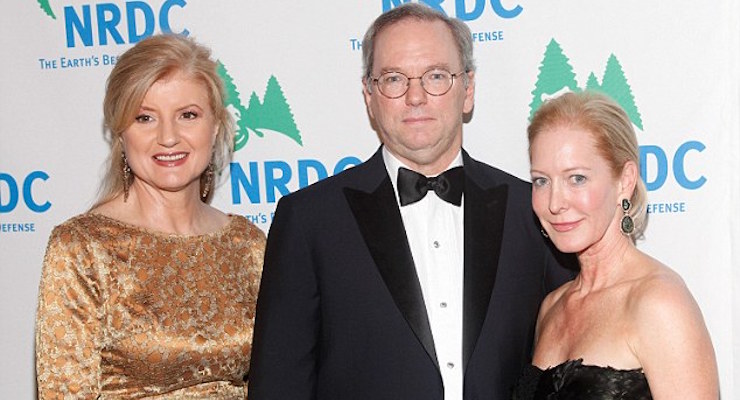

Chairman of Google Eric Schmidt, centre, and his wife Wendy Schmidt, right, are set to have the second most expensive divorce in history; they are pictured with Arianna Huffington, left. (Photo: Getty Images)
As a select few accumulate massive fortunes, two schools of thought vie on how to funnel some of that money toward the public good. One school says to hike taxes on billionaires and let our elected officials spend the revenues on worthy projects. That’s involuntary giving, and the giver doesn’t have much of a say about where it goes.
The other school backs the light taxation of great wealth and applauds when the superrich make large charitable donations. The giving is voluntary (spurred on by tax incentives), and the money goes exactly where the donor directs it.
The second school, encouraged by the conservative doctrine of cutting taxes and spending, is winning. It’s interesting, though, to examine where the private money ends up. Privatized funding for science has favored a few regions, and usually not the conservative ones. The big donor dollars have been congregating in progressive enclaves on the East and West coasts and in the Upper Midwest.
Three examples:
–Theodore Stanley, fortune made in collectibles, gave $650 million to the Broad Institute in Cambridge, Massachusetts, to study genetics and mental illness.
–Paul Allen, a co-founder of Microsoft, gave $100 million to set up the Allen Institute for Cell Science in Seattle.
–Google Executive Chairman Eric Schmidt and his wife, Wendy, created the Schmidt Ocean Institute in Palo Alto, California, writing checks totaling more than $100 million.
Under federal guidelines, government grants for scientific research must be spread around geographically. The recently passed 2016 spending bill does restore some of the science funding so ruthlessly cut over the past decade. But it’s unclear what difference that will make on a map that shows concentrated science spending in a few research centers.
In 2004, Fred Kavli, a tech and real estate magnate, set up a foundation establishing 14 science research institutes in the United States. Where are they? In California, at Stanford University, the California Institute of Technology and three campuses of the University of California. In the Northeast, at MIT, Harvard, Cornell, Yale, Johns Hopkins and Rockefeller University. And there’s one at the University of Chicago.
Big private money begets more big private money. When Charles Munger, Warren Buffett’s partner in Omaha, decided to make his $65 million gift to science, he chose the Kavli Institute for Theoretical Physics at UC Santa Barbara.
The Broad Institute, to which Stanley made his huge gift, was created through $700 million in donations by Eli and Edythe Broad, who grew rich off housing and insurance.
The federal government remains the biggest supplier of science research dollars, but years of cutting back has forced American universities to turn to private donors for funds. A study of National Science Foundation data shows that by 2012, Americans had to find money for over 19 percent of their research, way up from just under 9 percent in 1962.
The institutions in the best position to tap donors are those where the donors live and party. And frankly, a lot of donors want their names plastered on the sides of buildings that their friends will see — at powerhouse institutions.
Facebook zillionaire Mark Zuckerberg and his wife, Dr. Priscilla Chan, have just put $45 billion in a limited liability company that they say will concentrate on “advancing human potential and promoting equality for all children in the next generation.” They say they want to cure diseases.
Those goals may be widely shared across this big, diverse country of ours. But one can bet that the bulk of those billions won’t be spent in the congressional districts of the politicians who created the conditions that have privatized spending for the public good. The law of unintended consequences at work.







David / February 17, 2016
The bottom line is more important than quality products. The push for quantity over quality and this is compounded when there are deadlines. Greed and sub-standard products. Pharmaceuticals are the best example.
/